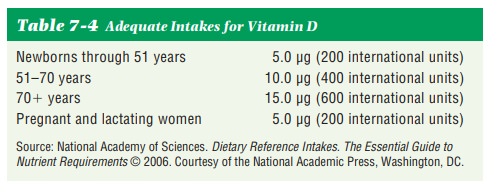Chapter: Nutrition and Diet Therapy: Vitamins
Vitamin D
Vitamin D
Vitamin D exists in
two forms—D2 (ergocalciferol) and D3 (cholecalciferol).
Each is formed from a provitamin when irradiated with (exposed to) ultraviolet
light. They are equally effective in human nutrition, but D3 is the
one that is formed in humans from cholesterol in the skin. D2 is
formed in plants. Vitamin D is consid-ered a prohormone because it is
converted to a hormone in the human body.
Vitamin D is
heat-stable and not easily oxidized, so it is not harmed by storage, food
processing, or cooking.
Functions.The major function of vitamin D is the
promotion of calciumand phosphorus absorption in the body. By contributing to
the absorption of these minerals, it helps to raise their concentration in the
blood so that nor-mal bone and tooth mineralization can occur and tetany
(involuntary muscle movement) can be prevented. (Tetany can occur when there is
too little cal-cium in the blood. This condition is called hypocalcemia.)
Vitamin D is absorbed
in the intestines and is chemically changed in the liver and kidneys. Excess
amounts of vitamin D are stored in the liver and in adipose tissue.
Sources.The best source of vitamin D is sunlight,
which changes a pro-vitamin to vitamin D3 in humans. It is sometimes
referred to as the sunshine vitamin. The amount of vitamin D that is formed
depends on the individual’s pigmentation (coloring matter in the skin) and the
amount of sunlight avail-able. The best food sources of vitamin D are milk,
fish liver oils, egg yolk, butter, and fortified margarine. Because of the
rather limited number of food sources of vitamin D and the unpredictability of
sunshine, health authorities decided that the vitamin should be added to a
common food. Milk was selected.
Consequently, most
milk available in the United States today has had 10μg of vitamin D concentrate
added per quart.
Requirements.Under the DRIs, there are several reference
values in-cluded. Vitamin D levels are given as Adequate Intake levels, or AI
(Table 7-4).

People who are seldom
outdoors, those who use sunscreens, and those who live in areas where there is
little sunlight for 3 to 4 months a year should be especially careful that
their diets provide their AI levels of vitamin D. Drink-ing 2 cups of vitamin
D–fortified fat-free milk each day will provide sufficient vitamin D to those
between birth and 50 years of age. Between the ages of 51 and 70, 1 quart of
such milk will be needed each day to fulfill the AI. After 70, 11 ⁄2
quarts will be needed daily. In this last age-group, a vitamin D supplement may
be needed.
Vitamin D or,
specifically, cholecalciferol values are given in micrograms (μg or mcg.) or in
international units; 5μg equals 200
international units.
Hypervitaminosis.Hypervitaminosis D must be avoided because it
cancause deposits of calcium and phosphorus in soft tissues, kidney and heart
damage, and bone fragility.
Deficiency.The deficiency of vitamin D inhibits the
absorption of calciumand phosphorus in the small intestine and results in poor
bone and tooth forma-tion. Young children suffering vitamin D deficiency may
develop rickets, which causes malformed bones and pain, and their teeth may be
poorly formed, late in appearing, and particularly subject to decay. Adults
lacking sufficient vitamin D may develop osteomalacia, softening of bones. A
deficiency of vitamin D con-tributes to osteoporosis (brittle, porous bones).
Related Topics